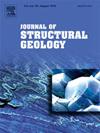Late Quaternary activity of the Songgang Fault on the eastern Tibetan Plateau from geological and geomorphological evidence
IF 2.6
2区 地球科学
Q2 GEOSCIENCES, MULTIDISCIPLINARY
引用次数: 0
Abstract
The Late Quaternary activity characteristics of faults are essential for understanding regional strain distribution and estimating seismic hazards. The Bayan Har block, located in the northern Tibetan Plateau, is a region with a high level of seismic hazard. Remarkably, over the past three decades, many strong earthquakes have occurred on the block boundary fault zones of the Bayan Har block. However, the 2021 Ms 7.4 Maduo earthquake and the 2022 Maerkang Ms 6.0 earthquake swarm were exceptions as they took place within the Bayan Har block, not on the boundary fault zones. The reason for the occurrence of these intraplate earthquakes presents an interesting research query. The Songgang Fault (SGF) is a NW-trending strike-slip fault within the Bayan Har block. The 2022 Maerkang Ms 6.0 earthquake swarm occurred 6 km northeast of the SGF. What role did the SGF play in the process of the earthquake swarm? Through utilizing high-resolution remote sensing image interpretation, detailed field geological and geomorphologic surveys, trench analysis, and dating technologies, we found that the SGF is a sinistral strike-slip active fault since the Late Pleistocene, exhibiting tectonic behavior conducive to the preparation and occurrence of moderately large earthquakes. OSL dating of dislocated stream channels reveals a left-lateral slip rate of the SGF yields 1.6–2.1 mm/yr since the Late Pleistocene. The SGF distributes and transmits the tectonic deformation within the Bayan Har block, accommodating southeastward lateral extrusion of the Bayan Har block materials and contributing to the kinematic mechanisms of the entire eastern margin of the Tibetan Plateau. Furthermore, the 2022 Ms 6.0 Maerkang earthquake swarm exhibits a conjugate rupture phenomenon in a complex tectonic zone where several secondary fault planes of the SGF converge. This main fault zone deserves attention as a potential source zone of future earthquakes.
青藏高原东部松岗断裂晚第四纪活动的地质地貌证据
断层晚第四纪活动特征对认识区域应变分布和估计地震危险性具有重要意义。巴颜喀尔地块位于青藏高原北部,是一个地震高发地区。值得注意的是,在过去三十年中,巴颜喀尔地块边界断裂带发生了多次强震。然而,2021年玛多7.4级地震和2022年马尔康6.0级地震群是例外,因为它们发生在巴颜喀尔地块内,而不是在边界断裂带上。这些板内地震发生的原因提出了一个有趣的研究问题。松岗断裂是巴颜喀尔地块内一条北西向走滑断裂。2022年梅尔康6.0级地震群发生在SGF东北6公里处。SGF在地震群发生过程中起了怎样的作用?通过高分辨率遥感影像解译、详细的野外地质地貌调查、海沟分析和测年等技术手段,我们发现SGF是一条晚更新世以来的左旋走滑活动断裂,表现出有利于孕育和发生中大震的构造行为。错位河道的OSL测年结果显示,晚更新世以来,SGF的左侧滑动速率为1.6 ~ 2.1 mm/yr。SGF分布和传导了巴颜喀拉地块内部的构造变形,容纳了巴颜喀拉地块物质的东南侧向挤压,并参与了整个青藏高原东缘的运动机制。此外,2022年梅尔康6.0级地震群在SGF多个次级断面交汇的复杂构造带中表现出共轭破裂现象。这个主要断裂带作为未来地震的潜在震源带值得关注。
本文章由计算机程序翻译,如有差异,请以英文原文为准。
求助全文
约1分钟内获得全文
求助全文
来源期刊

Journal of Structural Geology
地学-地球科学综合
CiteScore
6.00
自引率
19.40%
发文量
192
审稿时长
15.7 weeks
期刊介绍:
The Journal of Structural Geology publishes process-oriented investigations about structural geology using appropriate combinations of analog and digital field data, seismic reflection data, satellite-derived data, geometric analysis, kinematic analysis, laboratory experiments, computer visualizations, and analogue or numerical modelling on all scales. Contributions are encouraged to draw perspectives from rheology, rock mechanics, geophysics,metamorphism, sedimentology, petroleum geology, economic geology, geodynamics, planetary geology, tectonics and neotectonics to provide a more powerful understanding of deformation processes and systems. Given the visual nature of the discipline, supplementary materials that portray the data and analysis in 3-D or quasi 3-D manners, including the use of videos, and/or graphical abstracts can significantly strengthen the impact of contributions.
 求助内容:
求助内容: 应助结果提醒方式:
应助结果提醒方式:


